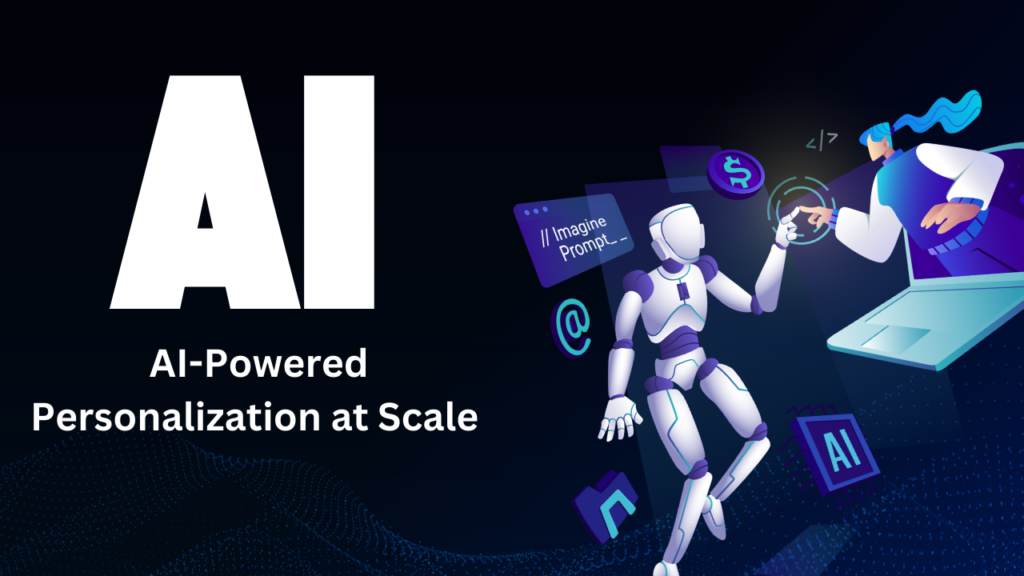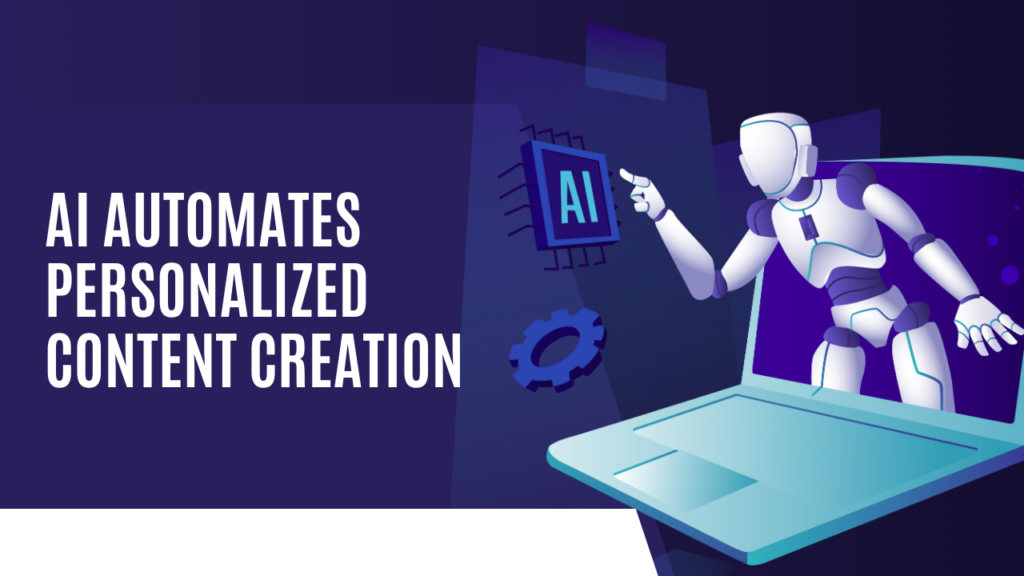Currently Empty: ₹0.00
Leveraging AI for Personalized Marketing Campaigns
AI for Personalized Marketing Campaigns,
The Problem: One-Size-Fits-All Marketing No Longer Works
For years, marketing teams relied on broad campaigns with generic messaging—sending the same emails, showing the same ads, and promoting the same offers to thousands, sometimes millions, of customers. It worked for a while. AI for Personalized Marketing Campaigns, But those days are gone.
Today’s consumers expect more.
A report from Accenture found that 91% of consumers are more likely to shop with brands that provide relevant offers and recommendations. Meanwhile, 74% of customers feel frustrated when website content isn’t personalized.
That means if your campaign treats everyone the same, AI for Personalized Marketing Campaigns, you’re probably leaving money—and customer loyalty—on the table.
The real issue isn’t that marketers don’t know personalization is important. It’s that delivering personalized experiences at scale is hard.
Think about it:
- How do you tailor thousands of messages to different customer preferences?
- How do you predict what each customer wants?
- And how do you do all this in real-time?
The answer lies in artificial intelligence.
Agitate: Why Current Approaches Are Failing (And Costing You)
Even when companies try to personalize campaigns, they often fall short.
Problem 1: Manual Segmentation Is Too Basic
Many brands still segment their audiences by age, gender, or location. But those categories are too broad. AI for Personalized Marketing Campaigns, A 30-year-old in New York might have completely different buying habits than someone the same age in Los Angeles.
Without deeper behavioral insights, marketers miss the mark.
Problem 2: Static Data Is Outdated Fast
Customers’ preferences change quickly. What someone was interested in last month might be irrelevant today. Using historical data that isn’t updated in real time leads to irrelevant messaging, which in turn causes disengagement.
Problem 3: Lack of Scalability
Creating personalized content for 10 customer personas? Doable. For 100,000 unique customers? Nearly impossible—unless you have a massive team and unlimited budget. Most marketing teams don’t.
And the cost? It’s real.
A 2023 Salesforce report revealed that 52% of customers switched brands in the last year due to poor personalization. Let that sink in. Over half of your customers might leave simply because they don’t feel understood.
That’s not just a missed opportunity. That’s lost revenue.
The Solution: AI-Powered Personalization at Scale

Artificial intelligence doesn’t just improve your personalization efforts—it transforms them.
Let’s break down exactly how AI enables smarter, faster, and more accurate marketing campaigns.
1. AI Builds Richer Customer Profiles
AI systems can process data from dozens of sources—website behavior, social media activity, CRM systems, past purchases, email opens, and more.
This means instead of just knowing a customer’s age or zip code, you get insights like
- What time of day they shop
- Which types of products they browse but don’t buy
- What content they click on
- How long they stay on a page
AI continuously updates these profiles in real time, giving marketers a dynamic understanding of each customer.
2. AI Predicts What Customers Will Do Next
Predictive analytics is one of AI’s most powerful tools. AI for Personalized Marketing Campaigns, By analyzing past behavior, AI can forecast future actions with surprising accuracy.
This includes:
- Predicting which products a customer is likely to purchase next
- Identifying customers at risk of churning
- Recommending the best time to send a message or offer
For example, Amazon’s product recommendation engine—powered by AI—accounts for up to 35% of its total revenue, according to a McKinsey report. AI for Personalized Marketing Campaigns: That’s personalization delivering massive business impact.
3. AI Automates Personalized Content Creation

Writing personalized emails for 100,000 customers sounds crazy. But AI can do it.
Using natural language generation (NLG) tools, AI for Personalized Marketing Campaigns, marketers can automatically generate product descriptions, subject lines, or even entire emails based on a user’s behavior or preferences.
In one case study, eBay used AI to generate over 1 million personalized email variations daily—each tailored to an individual user’s browsing history. This led to significantly higher open and click-through rates.
4. AI Optimizes Campaigns in Real-Time
AI tools don’t just personalize content—they learn which messages perform best and adjust accordingly.
This means
- Testing different subject lines or offers automatically
- Adjusting ad bids based on real-time engagement
- Reallocating budget to the best-performing channels without human input
A practical example? Starbucks’ DeepBrew AI system analyzes customer preferences and usage patterns across its app. It then personalizes offers, recommends new drinks, and even influences inventory decisions at local stores. This kind of hyper-targeted marketing has driven customer retention and increased order frequency.
Real-World Case Study: The North Face
Let’s look at a full-scale implementation of AI personalization in action.
The North Face, an outdoor apparel brand, partnered with IBM Watson to create a voice-powered shopping experience.
Here’s how it worked:
- Customers answered a few questions like, “Where and when will you be using your jacket?”
- Watson processed that input alongside customer data, weather conditions, and product specs
- It then recommended the best products for that scenario
Results:
- Customers spent more time engaging with the site
- Conversions increased due to better product matches
- User satisfaction improved significantly
By understanding not just the “who” but also the “why” and “how,” The North Face used AI to turn browsing into buying.
Getting Started: How to Integrate AI Into Your Marketing Campaigns
Ready to leverage AI for personalized marketing? Here’s a step-by-step approach.
Step 1: Centralize Your Data
AI thrives on data. Make sure your customer data is unified and accessible—whether it’s coming from your CRM, website, social media, or email platforms.
Use a Customer Data Platform (CDP) if necessary. Tools like Segment or Salesforce CDP help pull all customer data into one place for AI to analyze effectively.
Step 2: Choose the Right AI Tools
Not every company needs to build its own AI model from scratch. Here are some tools to consider:
- Persado: AI-powered copywriting for personalized messages
- Dynamic Yield: Real-time personalization across web and mobile
- Drift: Conversational AI for chat-based engagement
- Blueshift: Predictive AI for email and cross-channel campaigns
Evaluate tools based on:
- Your campaign goals (email, ads, website, etc.)
- Integration capabilities
- Real-time analytics features
Step 3: Start Small and Test
You don’t have to revamp everything overnight. Start with a single campaign.
For example:
- Use AI to personalize subject lines based on user behavior
- Test predictive product recommendations in emails
- Experiment with dynamic landing pages that change based on the visitor
Track metrics like open rates, click-through rates, conversion rates, and revenue impact.
Step 4: Scale With Confidence
Once you see results from smaller tests, expand personalization across more channels.
Combine email, web, SMS, ads, and push notifications into one consistent experience. AI makes omnichannel personalization realistic without increasing your workload.
The Numbers Back It Up
AI-powered personalization isn’t just a trend—it’s driving real business outcomes.
Check these stats:
- 80% of customers are more likely to purchase from a brand that offers personalized experiences (Epsilon)
- Marketers who use AI see an average increase of 20% in sales (Forrester)
- AI can reduce customer acquisition costs by up to 50% (Boston Consulting Group)
Those aren’t minor gains. They’re game-changing.
The Bottom Line: Personalized Marketing Isn’t Optional—It’s Expected
If your marketing messages still feel generic, customers will tune you out. And once they do, it’s hard to win them back.
Artificial intelligence gives marketers the tools to meet growing customer expectations without burning out their teams. It’s not about replacing creativity—it’s about amplifying it.
When AI handles the data, prediction, and personalization at scale, your team can focus on what they do best: crafting stories, building connections, and delivering value.
Final Thought
If you want to future-proof your marketing strategy, it’s time to get serious about AI.
Start small. Stay focused. Use data wisely. And always put the customer experience first.
Because in a world full of noise, personalization powered by AI is how your brand stands out—and stays remembered.
Ready to start? Begin with your next email campaign. Add AI-powered personalization. Track the results. And watch how a small shift leads to bigger wins.
Need help evaluating AI tools for your campaigns? I’m here if you want a checklist or recommendation list—just let me know!
Q1: What is personalized marketing?
A: Personalized marketing is the strategy of tailoring marketing content, messages, and experiences to individual customers based on their behavior, preferences, and data. Instead of sending the same message to everyone, businesses use personal insights to make each interaction more relevant and effective.
Q2: Why is personalization important in modern marketing?
A: Because customers expect it. Studies show that 91% of consumers are more likely to shop with brands that provide relevant recommendations. Personalization increases engagement, conversions, and loyalty by delivering experiences that feel meaningful and tailored to each person.
Q3: How does AI enable personalization at scale?
A: AI can analyze massive amounts of data quickly and identify patterns that humans might miss. It builds dynamic customer profiles, predicts future actions, and generates personalized content in real-time. This means you can serve thousands—or millions—of users with individualized experiences without manual work.
Q4: What types of data does AI use for personalization?
A: AI typically uses:
- Behavioral data (clicks, purchases, browsing history)
- Demographic data (age, gender, location)
- Contextual data (device, time of day, weather)
- CRM data (past interactions, loyalty level)
- Third-party data (social activity, interests)
The more accurate and updated the data, the better the personalization.
Q5: What are common AI tools used for marketing personalization?
A: Some widely used tools include:
- Dynamic Yield (real-time content personalization)
- Persado (AI-generated marketing copy)
- Salesforce Einstein (predictive insights and customer journeys)
- Blueshift (cross-channel marketing automation with AI)
- Drift (AI chatbots for personalized engagement)
Each has strengths depending on your campaign goals and customer touchpoints.
Q6: What’s an example of AI personalization done right?
A: The North Face used IBM Watson to create a shopping experience that recommends jackets based on customer needs and weather conditions. Customers interacted with an AI assistant, which delivered highly personalized product suggestions—leading to increased engagement and higher conversion rates.
Q7: Can small businesses use AI for marketing, or is it only for big companies?
A: Absolutely! While big brands may build custom AI systems, small businesses can use plug-and-play tools like Mailchimp with AI recommendations, HubSpot, or Klaviyo. These platforms offer AI features without needing technical skills or huge budgets.
Q8: What’s the biggest challenge in using AI for marketing?
A: One major challenge is data quality and integration. If your customer data is scattered or outdated, AI won’t perform well. Businesses need clean, centralized, and real-time data to feed the AI. Also, understanding how to balance automation with human creativity is key.
Q9: How do you measure the success of AI-powered personalization?
A: Track key performance indicators (KPIs) such as:
- Email open and click-through rates
- Conversion rates
- Average order value (AOV)
- Customer lifetime value (CLV)
- Customer retention or churn rate Compare these metrics before and after implementing AI personalization.
Q10: Is AI replacing human marketers?
A: No. AI is a tool that supports marketers—not a replacement. It handles data analysis, predictions, and automation, allowing human marketers to focus on strategy, creative direction, and customer relationships.
Q11: What exactly does “personalized marketing” mean, and how has AI transformed it?
A:Personalized marketing is the practice of delivering customized messages, offers, and content to individual users based on their data, preferences, behaviors, and interactions with a brand. Instead of grouping customers into broad demographics like “millennials” or “women aged 30-45,” personalization aims to treat each customer as a unique individual.
Traditionally, marketers used segmentation to group customers into categories. But these segments were often too broad, and personalization efforts were limited by the amount of data marketers could manually analyze and act upon.
AI has transformed this process by automating data analysis and making it possible to personalize interactions at scale. With AI, marketers can analyze millions of data points in real-time—from browsing behavior and purchase history to device type and weather conditions—to understand what each user is likely to want, when they want it, and how they want it delivered.
AI doesn’t just automate personalization—it elevates it. Through techniques like predictive analytics, machine learning, and natural language processing (NLP), AI can:
- Predict customer behavior
- Generate unique content automatically
- Recommend products or offers based on real-time signals
- Adjust campaign strategies without human intervention
This means AI allows brands to personalize across entire customer journeys, in real-time, with far greater accuracy and speed than ever before.
Q12: What types of AI technologies are commonly used in personalized marketing, and how do they work?
A:Several AI technologies power personalized marketing. Each serves a different function in helping marketers understand, predict, and serve individual customer needs:
- Machine Learning (ML):
ML algorithms analyze patterns in customer data to predict behavior. For example, ML can determine which customers are most likely to convert, which email subject lines get the most opens, or when a customer is likely to stop buying. - Natural Language Processing (NLP):
NLP allows AI to understand and generate human language. It’s used in chatbots, product description generation, email content creation, and sentiment analysis. Tools like Persado use NLP to write emotionally resonant content at scale. - Predictive Analytics:
This involves using historical data to forecast future customer actions, such as purchases, churn risk, or engagement levels. AI tools analyze thousands of variables to assign probability scores to customer actions. - Recommendation Engines:
These systems suggest products, content, or services tailored to individual users. Amazon’s recommendation engine is a famous example, and it contributes to 35% of the company’s revenue. - Computer Vision and Voice Recognition:
While not always directly tied to marketing, these technologies are used in certain channels—for instance, recognizing user content preferences on visual platforms like Pinterest or enabling voice-based product searches via smart speakers.
Each of these AI tools works in harmony within larger platforms or custom marketing stacks to deliver relevant and timely experiences to customers.
Q13: Can you provide a real-world case study that shows AI’s impact on personalized marketing?
A:Yes. One strong example is Sephora, the global cosmetics brand.
Challenge:
Sephora wanted to deliver a more personalized experience across channels—especially as customers were engaging through mobile apps, websites, and physical stores. With a wide product catalog and millions of customers, creating tailored experiences at scale was a challenge.
AI Solution:
Sephora implemented AI in several ways:
- Chatbots powered by NLP helped users find products based on their skin type and preferences.
- AI-driven product recommendations were personalized for each user on both web and mobile.
- AI analysis of customer profiles allowed for targeted emails based on prior purchases and preferences.
Results:
- A 14% increase in conversion rates from personalized product recommendations
- Stronger email open and click-through rates from personalized content
- Higher customer satisfaction scores in post-interaction surveys
Sephora’s use of AI shows how smart personalization can blend physical and digital experiences, making shopping more intuitive and increasing lifetime value.
website link – jioskill.com https://codexon.in/







